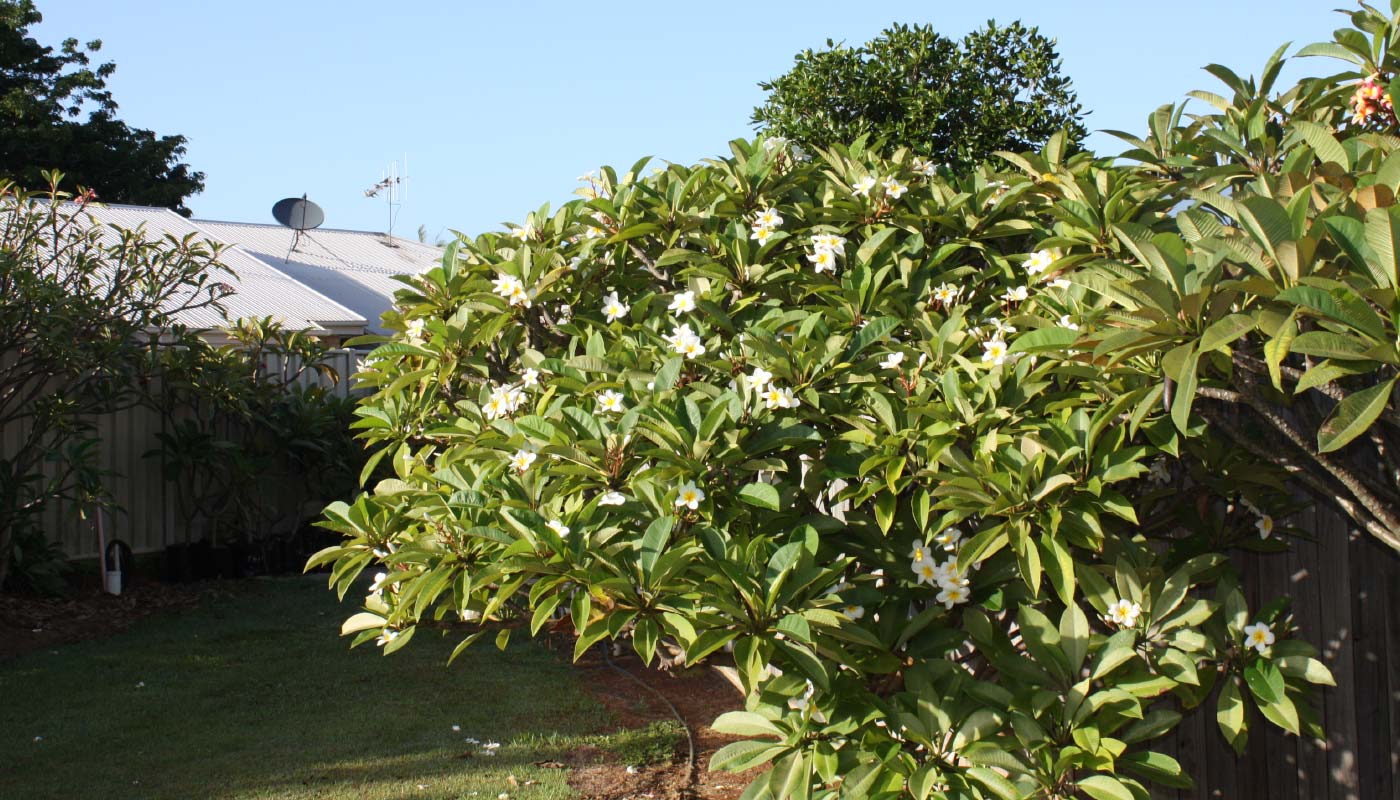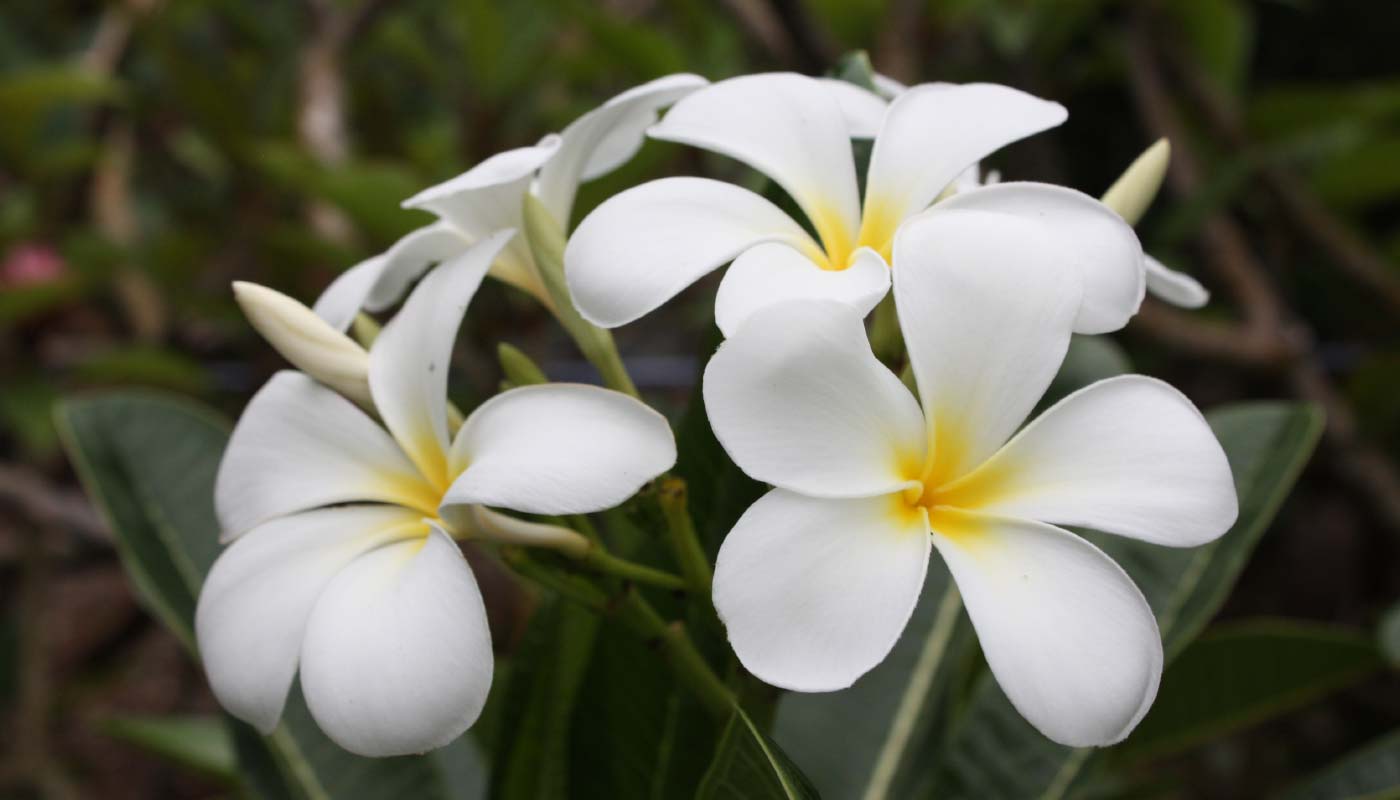FAQs
FAQs
How to prune Frangipani?
Pruning is easiest in winter, following leaf drop, but heavy pruning sacrifices the spring blooms. Stems that are shrivelled and bent or damaged can be removed back to their juncture with a main branch and destroyed.
Many old trees in home landscapes have responded well to the pruning practice known as stag horning in Australia. Stag horning is a method in which a framework of branches is established with yearly pruning back on each main limb to a point where sub branching resembles a stag horn shape.
This head develops several growing points because of the pruning, and each year a new group of shoots is produced. In plumeria, the new shoots may develop flowers late in the year if stag horning is done during the dormant season. Stag horning during the summer growing season will produce a series of short branches that will not set a flower head but will go dormant in autumn and grow out as longer branches the next year, many of which will flower in late summer.
Prune or wound dressing is available from most hardware stores such as Bunnings and when applied protects the cut surface as it heals, and a new growth of cells and bark covers the cut surface.
Thinning out 15 to 20 percent of the canopy of your mature frangipani is good to do every few years; it opens the branches, allows light in, and reduces stem rot.
Occasionally, you may need to prune your frangipani to restrict size, tidy a broken branch or to remove an inconvenient branch. On older trees, look for any branches that have started rubbing or crossing over, or have stopped producing foliage or flowers, and remove them.
Growing Plumeria in Australia
Plumeria Rubra and the wide range of hybrids are frost tender, so in Australia it is widely grown in the tropical and subtropical areas of Western Australia, Northern Territory, Queensland and in warmer coastal positions in Victoria and South Australia. I have seen specimens growing in glasshouses in Tasmania and New Zealand and in gardens in the North Island of New Zealand.
Growing frangipani in warmer coastal climates
Plumeria is a common ornamental in yards and other planned landscapes. It is easy to grow in hot, dry areas and is found in Australia from sea level to the mountain ranges in warmer parts of Australia. It requires full sun and grows best in well drained, slightly acidic soil. It has moderate wind resistance and salt tolerance.
To flower well, Plumerias require at least a half-day of direct sun, but they perform best in full sun.
Prevent mulch from touching the base of frangipani trunks, as otherwise you are encouraging basal rot to occur during wet weather.
6 to 8 hours of direct sunlight is needed for good blooming of your plumeria. Some varieties require some shade from the hot inland sun in the summer months.
Growing frangipani in cooler frosty climates
Plumerias are very sensitive to frost and if grown in containers they can be moved inside when night temperatures in autumn start to drop below 10 DegC. If conditions indoors allow for continued growth, provide water on a regular basis, but only after the soil becomes moderately dry. If conditions are less than ideal, allow the plant to go dormant for the remainder of winter. During this time, plumerias require no water or light. All the leaves will be shed and the plant will resemble a defoliated tree limb or a stick, and will rest until spring. Move outdoors only after all danger of frost is past and night temperatures stay above 10 DegC.
Always plant frangipanis at the same depth as they were in the container and keep mulches from touching the base. Their trunks are prone to fungal decay, particularly in cold, wet weather.
The further south you live in Australia and the further inland you grow frangipanis the more important warmth, drainage, sunshine and frost protection become for establishment.
Planting near masonry walls, buildings or in paved areas provides shelter from wintry winds and reflects warmth. Frangipanis grow about 30–60cm a year, depending on climate and care. Frost kills shoot tips, and damaged tissue can decay, leading to dieback. This is not fatal but spoils appearances and reduces flowering. Cut back affected stems to a healthy branch in spring.
In cooler areas it is still possible to grow frangipani if the microclimate around the house is warm. Radiating sun and heat from brick paving, walls or mirrors will help the frangipani withstand cooler winters, so keep them close to the house.
Growing Frangipani from seed
Plumeria can be propagated from seed. Fancy Frangipanis has hybrid seed available for purchase which we collect from our stock gardens.
If you collect your own seed from plants with white flowers it produces mostly white-flowered seedlings. Similarly, dark red will produce red, and yellow will produce yellow, but pinks and multicolored plants are more likely to produce a range of colours in the seedlings.
Although this is a rule of thumb our experience has shown that natural cross pollination occurs in frangipani seed set amongst mixed plantings of frangipani with amazing variations in flower shape and colours evident in flowering seedlings. Frangipani flowers are most fragrant at night in order to lure sphinx moths, just one type of night flying moth that has been shown to cross pollinate them.
Collect seeds when the pod dries and splits open exposing the rows of winged seeds. Sow them shallowly in pots or trays. Dry seeds will keep for about three months in a plastic bag before beginning to lose viability. Seeds germinate in about two weeks. Transplant seedlings to individual pots when one or two pairs of true leaves have developed, and move the plant up to a larger container until it is large enough to plant out
Seedlings take around three years or more to produce flowers. Some seedlings in our collections have been known to take up to 12 years to commence flowering.
Plumeria Seeds are one of the most sought-after seeds in the world because their flowers are one of the most exotic and beautiful breeds in any garden.
How to water Frangipani?
For best growth and flowering in the landscape, irrigation is needed during dry periods of the growing season.
Keep the soil evenly moist during the summer growing season but allow some drying to occur in between thorough watering’s. Always avoid soggy conditions, as this could lead to root rot. On the other hand, excessive dryness will result in yellow leaves and foliage loss.
But be careful not to over-water frangipanis as they prefer to be on the dry side and too much water can prove disastrous
Water regularly to help plants establish during the summer growing season but allow plants to go dry in between watering’s. Never saturate soil. After the first season following planting, your frangipani may need infrequent watering’s during summer conditions if little rain autumns to improve root system development and uptake of nutrients to aid in growth and strong seasonal flowering.
Water is very important to your plumeria. Your plant must have enough water in the summer months. Without adequate water your frangipani could go into a suspended state or dormancy. The plant will abort flower stalks and the leaves will drop. Watering depends on the daytime temperature and humidity; a good balance is essential. Plumerias do not like standing water, do not use a catch bowl under a potted Plumeria.
When the plant drops its leaves in the cool autumn and winter months cut back watering. Give it only enough water is necessary to keep the soil slightly moist. Mist the stem if it begins to look wrinkled.
Plumeria should almost be treated like cactus or succulent. The major thing that can go wrong with growing frangipanis is that people tend to overwater their plants.
Feeding Frangipani nutrients is important
Fertilize plumeria with a high analysis NPK a couple of times during the growing season at about 100g per 25mm of trunk diameter, distributing the fertilizer evenly within the growing area under the tree canopy and extending just beyond the canopy or foliage line
A regular fertilization program with a formulation high in phosphorus will produce vigorous plants with large clusters of flowers that generally appear from early summer into autumn. “Blossom booster” fertilizers give excellent results.
Avoid fertilizers just high in nitrogen, which tend to produce leggy plants with few blooms. Feed every other week during the growing season but discontinue in late summer to allow the new growth to harden off prior to winter.
A well-fed frangipani makes a more robust, disease-resistant plant and fertilisers that have a balanced micro-nutrient supplement are ideal.
Although in fertile soils frangipani rarely need feeding, they will flower bigger and better than ever if you spread some fertiliser around the drip line (under the branches) during spring and summer.
What soil type do Frangipanis like?
Frangipanis are not fussy and suit a wide range of soils, but well-draining soils are essential. In areas with heavier soils, plant in raised beds with free draining mix or in pots filled with good-quality potting mix.
Waterlogging quickly kills roots, especially in southern Australian winters. Keep cuttings and plants dry in winter. In clay soils, plant trees in a mound 15cm above the surface to help drainage.
Plumerias, roses, citrus trees and fruit trees are happy in soils with pH 6 to 6.5.
Plumeria plants require slightly acidic soil. Constant fertilization can drop the pH by increasing the acidity of the soil. However, if this happens obtain a soil additive from your local hardware that can be added to the soil to increase pH levels.
If plants continue to struggle in clay soils where it is hard for water to drain away, lift them out and replant into large containers where you can manage their growth and enjoy the flowers.
How big do Frangipanis grow?
Frangipanis are slow growing and take time to reach full maturity.
Plumeria is generally a small tree growing to as much as 6 meters. I have had the opportunity to see mature trees in Hawaii that stand over 8m in height and carpet the ground under the trees with beautiful flowers.
Usually the round-headed canopy is often about as wide as the tree is tall however you can prune trees to any shape that you choose.
The Australian hybrids vary somewhat in tree size, compactness, and branching character, leaf and flower size and colour.
The trees reach maturity in about five years in the tropics however they are slower growing in the cooler climates.
Sourcing larger advanced landscape trees is popular when planning a garden feature in cooler locations in Australia.
Minor pests and diseases of Frangipani
Plumerias are fairly resistant to insects and diseases, though spider mites will sometimes infest buds and new growth, especially indoors when conditions are hot, and the humidity is low. Spider mites can be controlled with forceful sprays of cool water that are strong enough to knock them from the plant. If need be, low toxicity sprays can be used.
Frangipani rust, Coleosporium plumeriae, was first detected in Queensland in 1993 and has now spread to many parts of Australia. Look for masses of tiny yellow-orange spots on leaf undersides during spring to autumn. Mature spots, called pustules, release spores that dust foliage below. Infected leaves autumn early. Remove and dispose of the infected leaves in the garbage because they are a source of reinfection. Frangipani rust is not fatal to a tree and helps in some cases to drop leaves ready for winter. Spraying early with sulphur or a copper-based fungicide helps control it but will not eliminate the problem.
A black sooty mold develops on stems and leaves when scale insects, whiteflies, or mealybugs are present. These insects exude a sweet, sticky honeydew upon which the fungus flourishes. Although unsightly, the fungus does not harm the tree (although the insects weaken it). Ants nourish the insects and carry them up into the trees. The control for the sooty mould problem lies with control of the insects.
How do Frangipanis produce seed?
Plumerias occasionally produce seed. When pollinated, the flower produces up to two hard, narrow, pointed pods 100 to 150mm long containing 20–60 winged seeds. Maturation of the seed pods is usually in early spring from a previous season’s pollination.
In mass plantings of different frangipani types the incidence of pod set or pollination is increased with the attraction of night flying moths that fly from flower to flower and naturally cross pollinate flowers. This technique has been used in Australia by Fancy Frangipanis to produce natural hybrids that exhibit the most amazing variations in flower shape, colour, and perfume.
It can take from 3 to 15 years to see the results of these crosses, however if you are patient it is worth the wait.
How to plant Frangipanis
Before planting frangipanis loosen up the soil and add compost or organic matter. For clay soils, work in gypsum at the recommended rate to improve air and water movement. Planting in a mound, about 15cm above the surface, improves drainage in clay.
Transplant during the warm seasons when recovery is fastest. Retain as many roots as possible and firmly stake until strong anchoring roots develop, this usually takes about 12 months.
Always plant frangipanis at the same depth as they were in the container and keep mulches from touching the base. Their trunks are prone to fungal decay, particularly in cold, wet weather.
When planting, dig a hole twice the size of the root ball. Work in organic matter and manures, in heavier soils apply Use an open mix along with one-part soil and one-part compost. Combine the cactus mix and soil at the bottom. Make sure the root ball is 25mm above the soil.
Planting avenues and feature hedge rows
When plumeria is grown for commercial flower production, it is planted 3 meters apart within rows and 4 meters between rows and pruned to keep the canopy low, encourage branching, and make harvesting the flowers more convenient.
Branched cuttings are selected for propagating, and the branch axil is set low to the ground to result in a shorter-statured plant.
How to Grow a Frangipani from a Cutting
1.
Cure Your Cutting
On arrival each cutting will be labelled and wrapped in a plastic sleave. Unwrap the cutting and place in a shady spot to dry out and form a callus. This takes around 7-10 days.
2.
Prepare Your Pot or Bag
Fill the supplied planter grow bag or your own pot (Select one that is over 20cm in depth) with a sandy, free-draining potting mix.
Bunnings has a good range of potting mixes and so do the local hardware stores. A seedling raising mix is suitable for striking cuttings and we have trialled many of these with great success.
3.
Insert Your Cutting
Firmly push the base of the cutting into the mix until it is inserted to around 10cm into the middle of the bag or pot.
Firm the mix around the cutting and position the potted cutting in a sunny, warm, wind-sheltered spot.
4.
Water Your Cutting
Water after potting and soak the potting mix to ensure that it is has absorbed water. Some potting mixes when first bought are quite dry and require soaking to wet up. Sometimes with these new potting mix it is a good idea to water once and let drain then water again the next day as most potting mixes are dry and take a bit to water up, don’t overwater frangipani cuttings as they will rot at the base.
Usually I do not water frangipani cuttings again after the first soaking until the first small leaves appear at the tip of the cutting buds.
Growing healthy frangipanis is easy and a lot of fun.
These tips from Fancy Frangipanis on how you can grow a frangipani tree from a cutting and create a tropical paradise in your garden have come from years of selecting and growing our own frangipanis from cuttings.

The heavenly fragrance of frangipanis makes them a wonderful tree to have in your garden. Their classy range of colours and flower types are hard to find in any other flowering plant with varieties featuring blooms flushed with pink, apricot and red.

Even though Frangipanis (Plumeria sp.) are deciduous, their flowers can be enjoyed for several months of the year, appearing from October/November and lasting well into April.

Although the ideal time to take cuttings is just as the trees are coming out of dormancy right through to the end of summer, cuttings can be taken and struck at any time of the year if handled correctly.
Testimonials
"Thanks Andy, you knew what you were talking about when you suggested the Singapore whites, they look amazing in our pool area! Andy was a pleasure to deal with, cannot wait for them to bloom."
"Wow, what a collection! I was looking everywhere for a red frangipani and finally found it here. Healthy cuttings, awesome packaging, great prices, highly recommend."
"My daughter loves her frangipanis, thank you very much."
"Great quality cuttings, crazy variety, top notch packaging, and speedy delivery. Thank you could not have asked for better."
"I had an issue with my order and Andy was amazing about it. Thank you so much, I will be buying again."
"My princess in pink and sunset red cuttings have rooted and are already putting out new leaves. Cannot wait to order more, thanks again!"
"I saw you on the news! I did not even know that so many different flowers existed. Thank you for the cuttings, cannot wait for them to flower."

